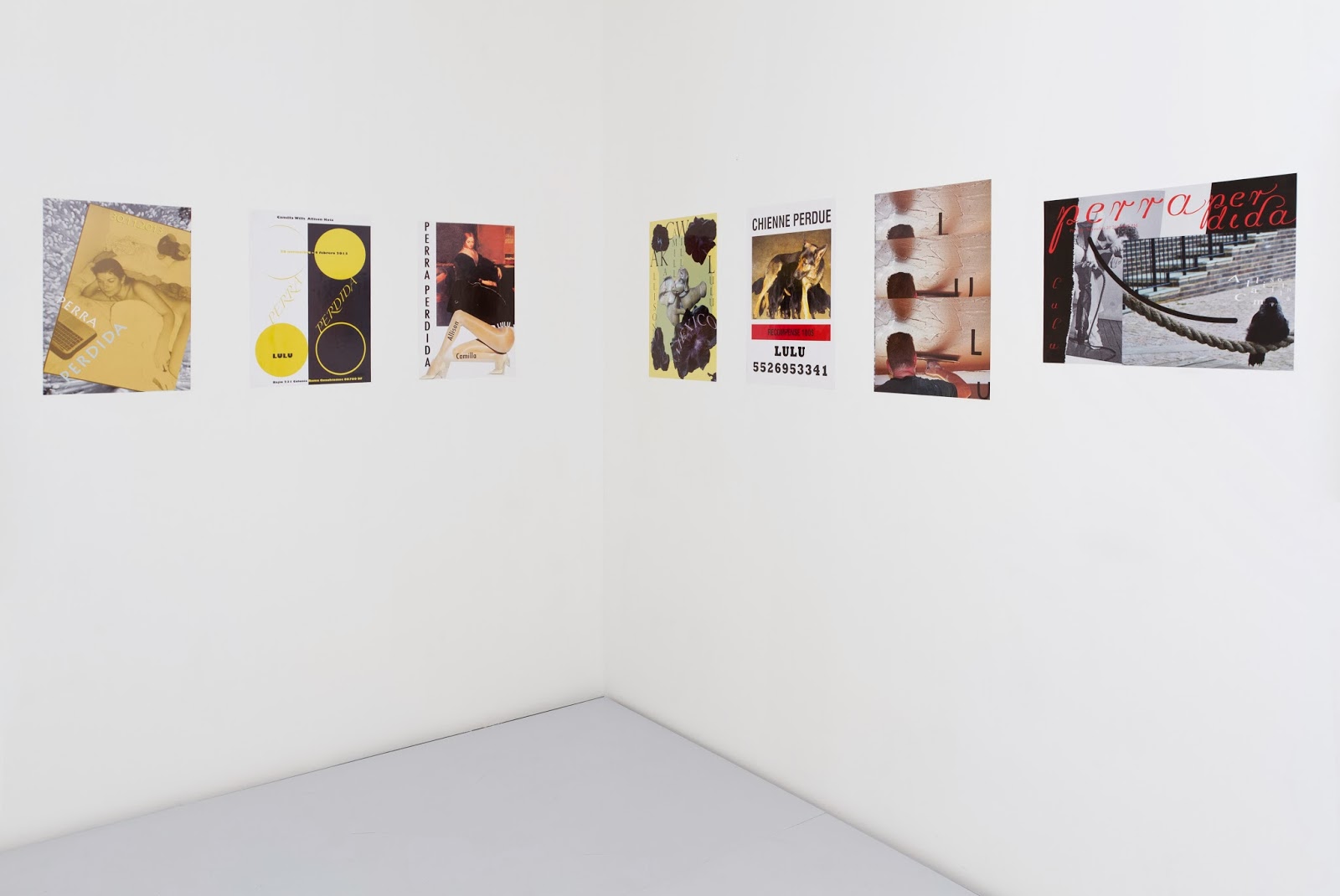Friday, February 28, 2014
Perra Perdida
Abyección:
Mezclar, ocasionar reacciones, efervescencias, espesamiento. Tratar con lo místico y lo perverso. ¿Acaso sigue el yo animal atado a su correa?
Burbujear.
Burbujear.
Abjection:
Mixing, causing reactions, effervescences, thickening. Dealing in the mystical and the perverse. Is the animal self still on a leash?
To fizz.
To fizz.
Gabriela Jauregui wrote this meditation in Spanish and in English as part of a longer text for Perra Perdida, a collaborative exhibition by Allison Katz and Camilla Wills at LULU, "an independent, Mexico City-based project space founded and run by the artist Martin Soto Climent and the independent curator Chris Sharp."
"The posters take as their starting point a found “chienne perdue” announcement, which Katz picked up in Quebec during the summer of 2011. Parodying the codes of information, the telephone number of the frantic owner is replaced with that of the curator. Katz and Wills take further liberties with the function of a poster: advertising the show becomes the show itself, another deferral, as a variety of information (title, names, venue, dates, city, contact information) circulates throughout the series of announcements, none of which take precedence as the official version."
"Down the hall, the action of the wall mural is a repetition and rearrangement of the posters. Redacted and abbreviated, they are a shorthand plea. Through the persistence of repetition, the trauma they announce is reclaimed as a source of pleasure; the decorative absorbs the loss. The pattern is indexical of the walk, the rhythmic call, the lack, and equally the excess of the search. Similar to propaganda textiles fabricated during WWII, an unlikely theme is promoted inside the usually safe, or neutrally, decorated interior. In a direct refutation of the flâneur or the tourist, Katz and Wills insert themselves into the context of Mexico City through a fantasy insistence that they have a pet, as only someone local could have, and by extension, are not lost or temporary, but already rooted in a sense of daily life."
Thursday, February 27, 2014
Skies
Watercolors from the Skies Sketchbook, in use from 1816 to 1818 on outdoor excursions by Joseph Mallord William Turner (1775-1851). Here is the official Tate Gallery account of the Turner Bequest –
After J.M.W. Turner’s death in 1851, the contents of his studio became the property of the nation. The Turner Bequest comprises around 30,000 works of art on paper, including watercolours, drawings and 300 oil paintings. Most works in the Bequest are unfinished pieces or preparatory studies.The Bequest provides a unique insight into Turner’s methods and documents his travels around Britain and Europe. In addition to mounted works, the Prints and Drawings Rooms hold 280 bound Turner sketchbooks.
Wednesday, February 26, 2014
Ten Corridors
Photographs by Carol M. Highsmith from an archive of images at the Library of Congress documenting the architecture of federal buildings around the country. Ten corridors.
Tuesday, February 25, 2014
Ha
The American movie Frances Ha began touring the festivals in 2012 and had its theatrical release in 2013 – but 2014 was well along before I saw it, even though many good things were said about it all over the place and there were black-and-white stills to admire on many different sites.
A black-and-white movie that looks back at the fluid, urban, rough-edged, black-and-white tradition in America and in France. Greta Gerwig is Frances. Her best friend Sophie is Mickey Sumner.
There was one note here that jarred with me, the same note repeated several times in several scenes. That jarring note was something called product placement.
Basically, the allure of the film depended on its spontaneous, intimate, Truffaut-style approach to the lives of current-young-fire-escape-bohemians-in-New-York. But now and then – just now and then – there would be the Bose headphones, the Acne tote-bag. And not only would these highly advertised objects feature prominently on camera (with logos carefully, lingeringly visible) but they would also be worked into the script as objects-of-note.
However, the fact that few* other viewers have mentioned this "incongruity" leads me to think that perhaps the problem is with me rather than with the movie. No doubt consumerism has penetrated society with such thoroughness by this time that the consciousnesses of the American twenty-something generation regards it as a universal & value-neutral reality rather than as a revelation of cold-hearted, manipulative, behind-the-scenes corporate interference.
*at least one other person did notice this same thing – "The ultimate hipster movie, acting like you're flat-
Monday, February 24, 2014
Daniel Chester French
The Metropolitan Museum designates Daniel Chester French "the leading American monumental sculptor in the early twentieth century." Born in 1850, he belonged to the large and busy generation that brought Beaux Arts style from Europe to the United States. By 1897 French was successful enough to build himself an estate called Chesterwood near Stockbridge, Massachusetts. It included a studio and gardens now preserved as a museum.
Images of surviving public works by Daniel Chester French (below) from the Carol M. Highsmith archive at the Library of Congress.
 |
| The Progress of the State, gilded quadriga, Minnesota State Capitol |
 |
| The Republic, gilded replica of colossal statue for World Columbian Exposition, Chicago |
 |
| Marble fountain, Dupont Circle, Washington DC |
 |
| Marble fountain, Dupont Circle, Washington DC |
 |
| Monument, Old North Bridge, Concord, Massachusetts |
 |
| America, marble statue, U.S. Custom House, New York |
 |
| Africa, marble statue, U.S. Custom House, New York |
 |
| Alma Mater, bronze statue, Columbia University |
 |
| History, marble statue, Library of Congress |
 |
| Lincoln Memorial, Washington DC |
Subscribe to:
Posts (Atom)











































